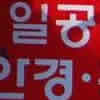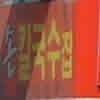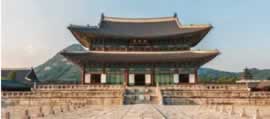Here is some information about cities in Korea
-
 The plaza in front of Seoul City Hall acted as the gathering place for thousands upon thousands of dedicated Seoul citizens during the 2002 FIFA World Cup Korea/Japan, and it got worldwide media consideration. At the focal point of Seoul뭩 money related and business locale, it has for some time been a bustling street with much movement Deoksugung Palace is adjacent, adding to the clog. As of not long ago, the plaza has just been stopped on uncommon events for real celebrations and occasions however new plans are in progress to change the range into a citizen뭩 plaza, free of movement.
The plaza in front of Seoul City Hall acted as the gathering place for thousands upon thousands of dedicated Seoul citizens during the 2002 FIFA World Cup Korea/Japan, and it got worldwide media consideration. At the focal point of Seoul뭩 money related and business locale, it has for some time been a bustling street with much movement Deoksugung Palace is adjacent, adding to the clog. As of not long ago, the plaza has just been stopped on uncommon events for real celebrations and occasions however new plans are in progress to change the range into a citizen뭩 plaza, free of movement.
The Seoul City Hall building was developed in 1926, a stone working with a particularly Renaissance pizazz. Development started in March of 1925 and was finished in October 1926-there is 1 cellar floor and 3 over the ground, made of metal and cement.
Headings :- Seoul Subway Line 1 or 2, City Hall Station, Exit 5
Seoul (서울, listen ▶) is the capital of South Korea and is a standout amongst the most crowded urban communities on the planet, situated in the northwestern piece of the nation on the Han River. It is an assigned exceptional city. On the foundation of South Korea (the Republic of Korea) in 1948 it turned into the capital of the nation, aside from a brief span amid the Korean War. Seoul is situated at 37°35′N 127°0′E.
 Seoul is situated in the northwest of the nation, south of the DMZ, on the Han River. The city is the political, social, social and temperate focus of South Korea. It is likewise a universal place for business, back, multinational partnerships, and worldwide associations. This, alongside its position as the capital of one of the world's biggest economies, has kept on raising its worldwide status. Today, it is a standout amongst the most noticeable images of the Korean financial Miracle of the Han River.
Seoul is situated in the northwest of the nation, south of the DMZ, on the Han River. The city is the political, social, social and temperate focus of South Korea. It is likewise a universal place for business, back, multinational partnerships, and worldwide associations. This, alongside its position as the capital of one of the world's biggest economies, has kept on raising its worldwide status. Today, it is a standout amongst the most noticeable images of the Korean financial Miracle of the Han River.
As per UN Population Division figures, Seoul's Urban Area contained 10.3 million individuals in 2003, making it the 22nd most crowded such territory on the planet. This positioning can change from various autonomous sources, where the metropolitan region environment and rural areas can make contrasts. Its thickness has enabled it to wind up noticeably a standout amongst the most carefully wired urban areas in today's all around associated economy. It additionally has more than 1 million enrolled vehicles which cause far reaching roads turned parking lots past midnight. The bigger Seoul metropolitan territory and suburbanite belt, which incorporates the significant harbor city Incheon and the to a great extent private city of Seongnam, is one of the world's most vigorously populated. As of late, the metropolitan government has completed a broad cleanup of the city's overwhelming air and water contamination, changing the beforehand dim climate into a cleaner one, however air contamination is as yet hazardous.
The historical backdrop of Seoul can be followed back similarly as 18 BC. In that year the recently settled kingdom of Baekje fabricated its capital Wiryeseong in the Seoul region. There are a few city divider stays in the range dating from this time, and Pungnap Toseong, an earthen divider simply outside Seoul, is generally accepted to be the primary Wiryeseong site. Amid the time when the Three Kingdoms battled for administration in Korea, the Seoul territory was frequently challenged. Control gone from Baekje to Goguryeo in the fifth century, and from Goguryeo to Silla in the 6th.
It was felt that lone the kingdom that controlled the Han River valley would have the capacity to control the entire of the landmass, since it was a focal point of transportation. This was the motivation behind why in the eleventh century the leader of the Goryeo Dynasty constructed a castle in Seoul, which was alluded to as the "Southern Capital".
Toward the start of the Joseon Dynasty, the capital was moved to Seoul (otherwise called Hanyang and later as Hanseong), where it stayed until the fall of the administration.
Initially, the city was completely encompassed by a gigantic roundabout divider (a 20-foot-high round stone post) to give its residents security from wild creatures, for example, the tiger, criminals and assaults. The city has developed past those dividers and despite the fact that the divider never again remains (aside from in the mountains north of the downtown region), the entryways stay close to the downtown area of Seoul, including most eminently Sungnyemun (normally known as Namdaemun) and Honginjimun (generally known as Dongdaemun). Amid the Joseon line, the doors were opened and shut every day, joined by the ringing of expansive chimes.
Amid the Korean War, Seoul changed hands between the Chinese-upheld North Korean powers and the UN-sponsored South Korean powers a few times, leaving the city intensely harmed after the war. [1] One gauge of the broad harm expresses that after the war, no less than 191,000 structures, 55,000 houses, and 1,000 processing plants lay in vestiges. [2] moreover, a surge of displaced people had entered Seoul amid the war, swelling the number of inhabitants in Seoul and its metropolitan region to an expected 2.5 million, the greater part of them destitute.
Taking after the war, Seoul was the concentration of a monstrous reproduction and modernization exertion due for the most part to need, additionally due to some degree to the typical way of Seoul as the political and monetary focus of Korea. Today, the number of inhabitants in the Seoul region makes up 24% of the aggregate populace of South Korea, and Seoul positions seventh on the planet regarding the quantity of Fortune 500 transnational organizations headquartered there. [3]
 Seoul was the host city of the 1988 Summer Olympics and additionally one of the scenes of the Football World Cup 2002.
Seoul was the host city of the 1988 Summer Olympics and additionally one of the scenes of the Football World Cup 2002.
On August 11, 2004, the South Korean Government reported that the capital city would be situated in the Gongju region starting at 2007, to facilitate the populace weight on Seoul and to get the legislature to a more secure separation from North Korea. The Government assessed that the move would most likely not be finished before 2012 [4]. Albeit part of the decision pronouncement, this arrangement touched off across the country debate. On October 21, 2004, the Constitutional Court decided that the extraordinary law for the migration of the capital is unlawful since the movement is a genuine national matter requiring national submission or update of the constitution, and soon thereafter the vast majority thoroughly considered the civil argument was.
In any case, the South Korean Government later declared arrangements to move all national government branches, aside from the Executive Branch, to Gongju, therefore sidestepping infringement of the Constitutional Court managing and still enable Seoul to be a National Capital in name as it were. The arrangement still can't seem to go ahead and no new declarations have emerged from that point forward.
 Learn-Korean
Learn-Korean









